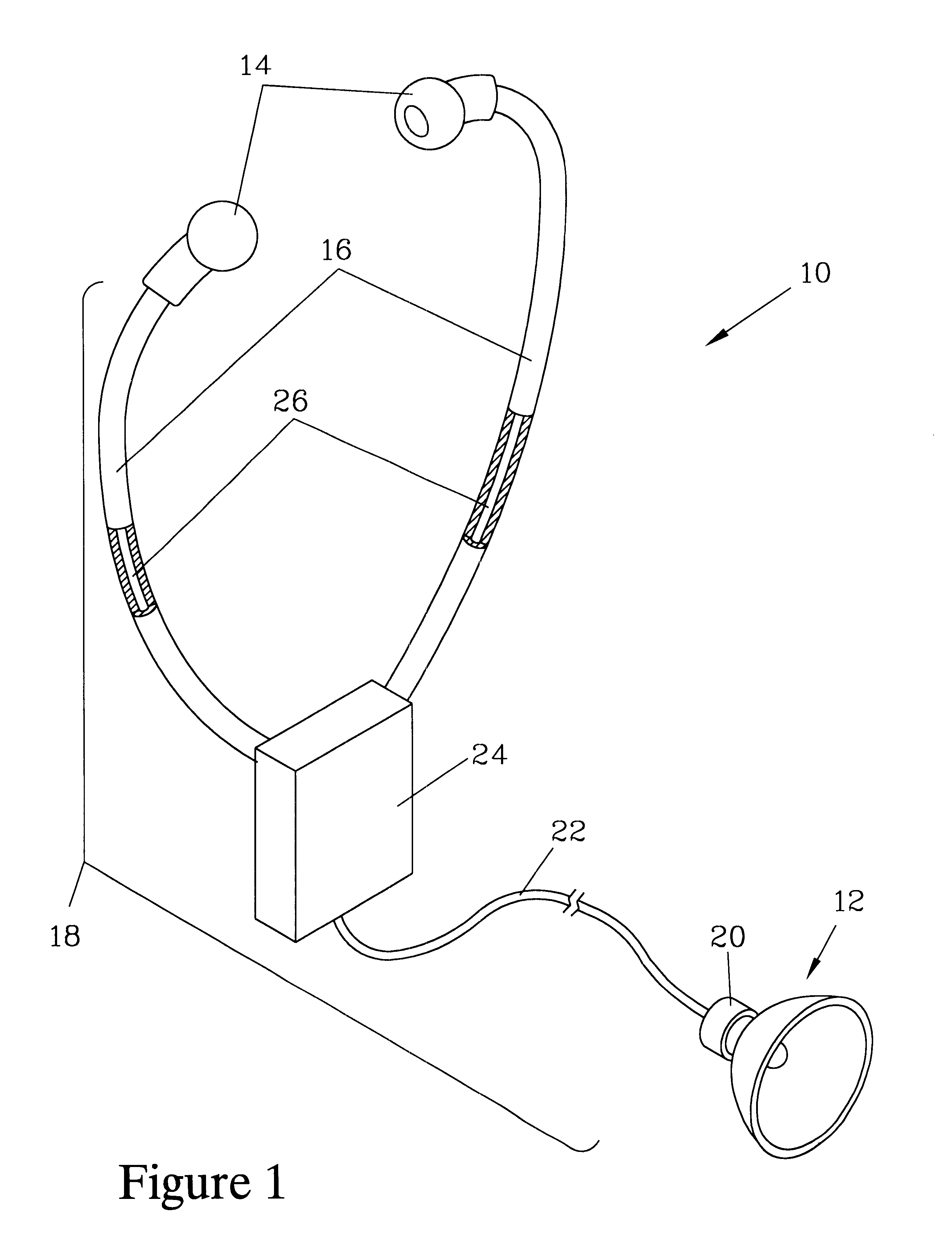A major obstacle when using Laennec's
monaural stethoscope was the tendency of unwanted sounds from the surrounding environment masking the desired sounds, since one ear was directly subject to sounds from the surrounding environment.
A significant problem with such open-ended stethoscopes is the low intensity of the sound transmitted to the observer's ear(s), due to loss in intensity of the sound as it crosses the interface between the
flesh of the patient and the air-filled sound chamber of the chest piece.
This signal loss is due to the differences in
mechanical impedance of the flesh, which is substantially liquid, and the air employed in the chest piece.
As a result, the signal received is low in intensity, and may be difficult to detect or distinguish over ambient
noise from the surrounding environment.
Another problem associated with these stethoscopes is that the
frequency response of these devices is dependent on the pressure with which the chest piece is applied to the body of the patient.
As the pressure applied to the chest piece increases, the chest piece causes
distortion of the flesh.
This
distortion results in the flesh of the patient filling a portion of the chamber and altering the volume and pressure of air in the sound chamber, altering its mechanical performance in amplifying sounds.
Thus, the
characteristic response of the chest piece is dependent on technique (the touch of the user), so the sounds heard may differ for different users, making comparison of results problematic.
While the Bowles stethoscope significantly increases the intensity of sounds in the frequency range of many of the sounds generated by the heart, the use of a diaphragm creates frequency-dependent
distortion due to the natural vibrational frequencies of the diaphragm.
Thus, while the Bowles type stethoscope offers a significant increase in the intensity (dB) of many of the sounds generated by the heart and other sounds of similar frequency heard by the user of the stethoscope, it reduces the intensity (dB) of
transmitted sounds generated by the heart or other organs which are in the frequency bands of reduced sensitivity, thus rendering the resulting stethoscope unsuitable for the observation of many sounds which may be of interest to the user.
Furthermore, if the diaphragm of the chest piece receives sounds from the surrounding environment which are in the
frequency band of increased sensitivity, these sounds are also amplified, thus tending to obscure the sounds monitored by the user of the stethoscope.
This is particularly a problem when monitoring impulsive sounds, such as heartbeats.
While electronic stethoscopes can provide amplified signals, they still suffer from frequency-dependent distortion (particularly when a conventional diaphragm is employed), pressure-dependent distortion, and from sound generated in the environment which reaches the sound chamber of the chest piece.
Pressure-dependent variation can be particularly problematic where electronic
processing of the received sounds is desired, since the pressure applied by the user can significantly alter the characteristics of the sounds to be processed, making filtering of the
noise component difficult.
Furthermore, such variation can make electronic recognition and / or analysis of the desired signal component of the sound impractical.
Amplification of the signal in electronic stethoscopes frequently results in amplification of sound from the surrounding in which the stethoscope is operated as well.
Because these stethoscopes employ air as the fluid medium transferring sound
waves to the
transducer, they frequently require substantial amplification to compensate for the signal loss caused by limited transfer of the
sound wave energy from the flesh to the transducer.
If the intensity (dB) of the sound from the surroundings in the unamplified sound transmitted through the sound chamber is sufficiently great as to
mask the sound generated by the organ of interest, simply amplifying the electronic signal produced by the transducer does not allow the sound emanating from the organ to be monitored.
In addition to sounds generated by the surrounding environment being transmitted through the sound chamber, another problem has been that movement of the chest piece over the skin of the patient generates sounds which are subject to amplification.
These sounds may not only obscure the sounds of interest, but also may be of sufficient intensity as to cause discomfort to the user.
Thus, the liquid would not substantially reduce the lower
frequency sound, which is often a large component of the unwanted external sound.
A further problem with all stethoscopes that has not previously been appreciated is that "unwanted external sounds" can also be indirectly transmitted though the membrane, since the body provides a conduction path for these "unwanted external sounds".
Even in liquid-filled chest pieces, it is felt that such conducted unwanted sounds would not be effectively attenuated, independent of their frequency.
This latter source of unwanted external sounds is particularly a problem in monitoring patients in high-noise environments, such as during transport where vehicle noise due to sirens, aircraft engines, helicopter rotors, etc. can be sufficiently loud as to
mask the desired signals from the body.
Since such transport often occurs in
emergency situations where monitoring is necessary to providing prompt diagnosis and treatment, this deficiency of existing devices is a serious limitation.
 Login to View More
Login to View More  Login to View More
Login to View More 


